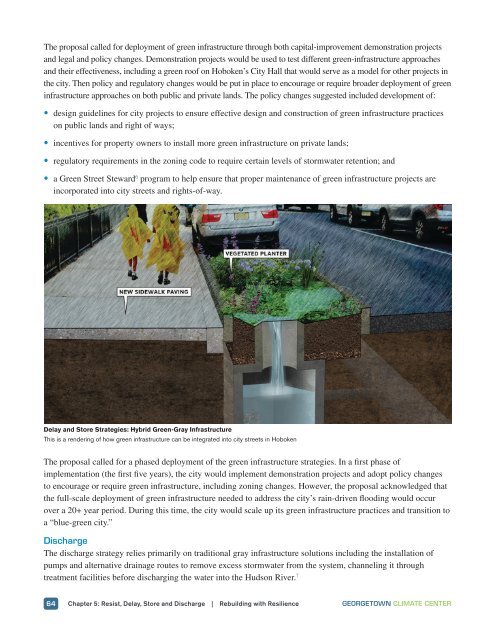Rebuilding with Resilience
dw0r306aHfX
dw0r306aHfX
Create successful ePaper yourself
Turn your PDF publications into a flip-book with our unique Google optimized e-Paper software.
The proposal called for deployment of green infrastructure through both capital-improvement demonstration projects<br />
and legal and policy changes. Demonstration projects would be used to test different green-infrastructure approaches<br />
and their effectiveness, including a green roof on Hoboken’s City Hall that would serve as a model for other projects in<br />
the city. Then policy and regulatory changes would be put in place to encourage or require broader deployment of green<br />
infrastructure approaches on both public and private lands. The policy changes suggested included development of:<br />
• design guidelines for city projects to ensure effective design and construction of green infrastructure practices<br />
on public lands and right of ways;<br />
• incentives for property owners to install more green infrastructure on private lands;<br />
• regulatory requirements in the zoning code to require certain levels of stormwater retention; and<br />
• a Green Street Steward 6 program to help ensure that proper maintenance of green infrastructure projects are<br />
incorporated into city streets and rights-of-way.<br />
Delay and Store Strategies: Hybrid Green-Gray Infrastructure<br />
This is a rendering of how green infrastructure can be integrated into city streets in Hoboken<br />
The proposal called for a phased deployment of the green infrastructure strategies. In a first phase of<br />
implementation (the first five years), the city would implement demonstration projects and adopt policy changes<br />
to encourage or require green infrastructure, including zoning changes. However, the proposal acknowledged that<br />
the full-scale deployment of green infrastructure needed to address the city’s rain-driven flooding would occur<br />
over a 20+ year period. During this time, the city would scale up its green infrastructure practices and transition to<br />
a “blue-green city.”<br />
Discharge<br />
The discharge strategy relies primarily on traditional gray infrastructure solutions including the installation of<br />
pumps and alternative drainage routes to remove excess stormwater from the system, channeling it through<br />
treatment facilities before discharging the water into the Hudson River. 7<br />
64 Chapter 5: Resist, Delay, Store and Discharge | <strong>Rebuilding</strong> <strong>with</strong> <strong>Resilience</strong> GEORGETOWN CLIMATE CENTER


